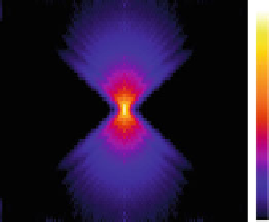Biomedical Engineering Reference
In-Depth Information
a
b
−6
−14
−16
−8
−18
−10
−20
Z
Z
−12
−22
X
X
Fig. 4.5
The axial MIP PSF on a log-scale for a 40X
/
1
.
4 oil immersion lens as imaged from
(
a
) WFM with a radial pixel size of 161 nm and a slice width of 300 nm; (
b
) CLSM with a radial
pixel size of about 47 nm and a slice width of 166 nm
Under ideal conditions, the PSF of a CLSM or WFM is a fully symmetric
3-D diabolo (or hour-glass) shaped image of an ideal point source (Fig.
4.5
a, b).
Note how the spatial support of the kernel is larger for the WFM than the CLSM.
Increase in the support in the spatial domain signifies a decrease in the support in
the Fourier domain. This provides an additional weight to the argument of reduction
in resolution for WFM. Much of the energy in the CLSM PSF is focussed in the
central ellipsoidal region. For this reason, an 'ideal CLSM PSF' is also modeled as
a 3-D Gaussian [
87
].
In the non-ideal case, the shape of the PSF is governed by the optical system used
and the experimental settings. In [
65
], it was shown that the PSF is dependent on
the lens, the wavelength and on the spherical aberration. In Fig.
4.6
a-c, we illustrate
this effect of the optical setup on the PSF. We note how the lowering of the NA
from 1
.
4 (in (a)) to 0
.
5 (in (c)) increases the size of the spatial support (increased
spreading of light) or decreases the frequency support.
Similarly, we can also show the dependence of the PSF on the fluorophore that is
used for tagging the sample. For example, in Fig.
4.7
, the radial and the axial plots
of the different PSFs are shown using the same setup but by using four different
chemical fluorophores. According to the excitation light that is used, the resolution
decreases as we go from 405 to 633 nm. This is quite in conjunction with the Abbe
limit (Eq.
4.1
) we discussed earlier in Sect.
4.1.1
. We conclude that a single PSF
alone is insufficient for deconvolving the observed images under all settings. The
practical way to handle this problem is to either generate the different PSFs before
deconvolution or to store them off-line for the different objectives and settings.
The effect of the specimen on the PSF is also important but a detailed discussion
on this subject would take another chapter in itself!
Comments on Empirical PSF and It's Distillation.
In a confocal, the PSF may
be independently obtained by identifying point sources from the observation, and
later used in combination with one of the image restoration algorithms. This
identification procedure [
22
] requires manual intervention, because both the PSF
and the point sources may not easily distinguished from noise. Due to this reason,


























Search WWH ::

Custom Search